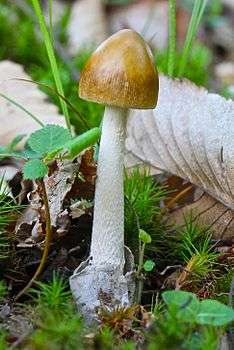Amanita sinicoflava
The Mandarin yellow ringless Amanita[1] (Amanita sinicoflava) is an inedible species of fungus in the large genus Amanita.[2] Found in North America, the fungus was described as new to science in 1998 by mycologist Rodham Tulloss. The type collections were made in Sussex County, New Jersey. The mushroom grows in sandy soil under Quercus, Pinus rigida, Acer rubrum, Quercus alba, and Quercus velutina. Fruitbodies have yellow-olivaceous or olive-tan caps that measure 2.5–7 cm (1.0–2.8 in) in diameter. There are grooves on the cap margin that extend about 40% of the distance from the margin to the apex. The spores are spherical or nearly so, typically measuring 9.1 to 12.2 micrometres (0.36 to 0.48 mils) by 8.4 to 11.5 micrometres (0.33 to 0.45 mils). The white stipe is ornamented with slightly darker fibrils, and there are sac-like remnants of the volva at the stipe base. The specific epithet sinicoflava means "Chinese-yellow", referring to the cap color.[3]
| Amanita sinicoflava | |
|---|---|
 | |
| Scientific classification | |
| Kingdom: | |
| Division: | |
| Class: | |
| Order: | |
| Family: | |
| Genus: | |
| Species: | A. sinicoflava |
| Binomial name | |
| Amanita sinicoflava Tulloss (1988) | |
| Amanita sinicoflava | |
|---|---|
float | |
| gills on hymenium | |
| cap is convex | |
| spore print is white | |
| ecology is saprotrophic | |
| edibility: inedible | |
See also
References
- Tulloss R. "Amanita sinicoflava". Amanitaceae.org. Retrieved 2015-06-17.
- Phillips, Roger (2010). Mushrooms and Other Fungi of North America. Buffalo, NY: Firefly Books. p. 21. ISBN 978-1-55407-651-2.
- Tulloss R. (1988). "Amanita sinicoflava: A new species from eastern North America". Mycotaxon. 32: 421–431.